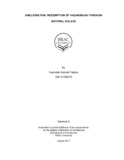| dc.contributor.advisor | Sajib-Bin-DOZA | |
| dc.contributor.advisor | Mahmudun Nobi, Abul Fazal | |
| dc.contributor.author | Fateha, Hamidah Ashrafi | |
| dc.date.accessioned | 2018-06-05T04:09:23Z | |
| dc.date.available | 2018-06-05T04:09:23Z | |
| dc.date.copyright | 2017 | |
| dc.date.issued | 2017-08 | |
| dc.identifier.other | ID 13108010 | |
| dc.identifier.uri | http://hdl.handle.net/10361/10256 | |
| dc.description | This thesis is submitted in partial fulfillment of the requirements for the degree of Bachelor of Architecture, 2017. | en_US |
| dc.description | Cataloged from PDF version of thesis. | |
| dc.description | Includes bibliographical references (page 56-57). | |
| dc.description.abstract | “An intense foul smell that burns all the way to the lungs”- is what many think of
as the name, Hajaribagh comes. The sole memory of a visit to the place leaves
many with a disturbing headache. Yet around 2, 00,000 people reside in such a
place with highly polluted environment filled with toxic waste produced by the
tannery industries situated in the area. While this highly degrading condition was
acknowledged long before, the forceful shut down of the tannery industries took
place as recently as on March 6, 2017.
Now that the industries have shut down, the growing concern is towards the redevelopment
of the land left behind by the tannery industries. The land is in an
extremely poor condition with much needed attention to its redemption. This
project addresses the concern as it takes a portion of the land and uses it to give
back the community what it has been missing. Additionally, it provides the
community with programs to enhance their living standards and attempts to bring
the community close to nature by involving it to initiate the growth and nurture of
nature within the site. The project also urges them to look closely as nature
grows and spread its branches to redeem the much-polluted place into a vibrant
natural one. As the project offers to allow the community to bond with the nature
and understand its importance, it creates a potential to make people more
empathetic towards the natural environment and thereby protecting it in the
future. It also leaves behind the story of the redemption of Hazaribag to be
passed down the generations of the community to make them feel the same
connection with the nature as their ancestors. | en_US |
| dc.description.statementofresponsibility | Hamidah Ashrafi Fateha | |
| dc.format.extent | 57 pages | |
| dc.language.iso | en | en_US |
| dc.publisher | BRAC University | en_US |
| dc.rights | BRAC University theses reports are protected by copyright. They may be viewed from this source for any purpose, but reproduction or distribution in any format is prohibited without written permission. | |
| dc.subject | Natural solace | en_US |
| dc.subject | Tannery industries | en_US |
| dc.subject | Amelioration | en_US |
| dc.title | Amelioration: redemption of Hazaribagh through natural solace | en_US |
| dc.type | Thesis | en_US |
| dc.contributor.department | Department of Architecture, BRAC University | |
| dc.description.degree | B. Architecture | |

